In three districts of Tamil Nadu, locals warmly reminisce about Pongal — a celebration that revolves around harvest, gratitude, simple yet satisfying treats, communal unity, and a deep love for cattle.

Pogal is a four-day harvest festival. (Supplied)
In a Tamil household, the saying Thai Piranthal Vazhi Pirakkum means more than just words — it’s a belief deeply imprinted into the pages of its rich culture. With the arrival of Pongal, a four-day festival heralding a celebration of the harvest, and marking the commencement of the Tamil month of Thai, this phrase, which translates to “With the arrival of the month of Thai, a path to harmony, prosperity, and joy opens up for everyone,” fills the air, capturing the optimism for positive outcomes.
For Mehandi DS, a native of Namakkal district, the celebration revolves around prayers for a bountiful harvest and prosperity. She shares, “Often, amid the urban hustle, the genuine spirit of Pongal escapes our attention. However, I make it a point to pray for my grandfather and all the farm workers, wishing them a fruitful harvest.”
Despite Mehandi having moved and resided in various parts of Karnataka, the allure of Pongal consistently pulls her back to her ancestral home in Namakkal, with only a few unavoidable exceptions.
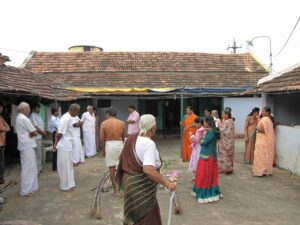
Relatives gather at the Mehandi’s ancestral house every year. (Supplied)
“Before the first day of the festival, Bhogi, the house is usually cleaned and whitewashed,” she says.
During Bhogi, it’s customary to prepare a bonfire and discard old clothes and other items into the fire, symbolising cleansing, and the ushering in of a new dawn.
“We don’t specifically engage in that tradition. But, we ensure our house is cleaned, the farm is well-maintained, and we abstain from consuming meat during these four festive days,” shares the design manager at Total Environment.
Reflecting on the festival, Mehandi warmly reminisces about the gathering of relatives in her ancestral house, actively participating in cleaning and various festive activities.
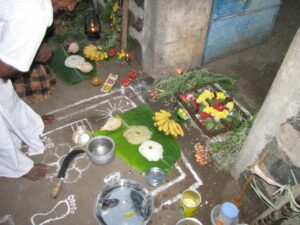
Sugarcanes, turmeric, and other offerings are placed on this kolam along with an aruval (Long sickle). (Supplied)
She details, “We will come together and decorate the multiple entrances and exits in the house with 5-6 kolams and rangolis. The sun and the moon are common motifs in these kolams. Sugarcanes, turmeric, and other offerings are placed on this kolam along with an aruval (Long sickle).”
“Additionally, lamps, bananas, and coconuts too are placed on these rangolis, representing dedication to the sun god, either in a courtyard or outside,” she describes.
In Mehandi’s household, a Pongal seeru — comprising vessels, rice, and money — is traditionally gifted to the females of the house on the auspicious day.
The Pongal menu typically encompasses three variations – a plain, rice pongal dish without garnish which goes alongside the light-on-the-stomach paasi payiru kadayal, sakkarai pongal (sweet pongal), and venn pongal made with rice, lentils and spices.
“The pongal becomes our staple for the entire day,” shares the 25-year-old.
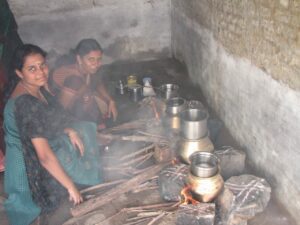
The pongal is made on a viragu aduppu (Wood-burning stove). (Supplied)
On Surya Pongal day, a vibrant kolam is once again drawn at the spot where the morning sun’s rays gracefully touch the ground. The pongal is expertly prepared in a traditional viragu aduppu, a wood-burning stove. As the pongal boils and overflows, it marks the commencement of the festival and the abundant blessings it brings.
“In the evening, another round of pongal is cooked in the temple, and the same food is served that night,” she shares. “But, personally, I’m not particularly fond of the dish,” she laughs.
While not giving much attention to the ghee-laden pongal, Mehandi’s favourite part of the festival always unfolds on the third day, Maatu Pongal.
“The festivities commence in the morning. I hold dear the memories that involve bathing the cattle on the farm, using sambrani to dry them up, and then decorating them with new bells. I used to take up this task, and I truly miss it,” she shares.
As time has passed, the number of cattle on her grandfather’s farm may have dwindled, but the precious memories are safe with her.
“It’s a tradition to lead the cattle through their shelter, making them stamp on a kolam outlined with cow dung. Pongal is then lovingly fed to the animals. Only after they have eaten do we indulge in our own portion of the Pongal,” she shares.
This year, Mehandi might miss the Pongal celebrations at Namakkal, but she hopes to celebrate it at her home in Bengaluru.
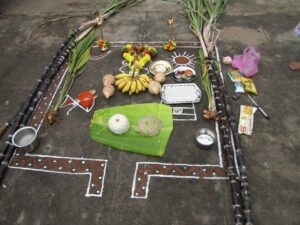
5-6 kolams adorn each entry and exit. (Supplied)
“The overall atmosphere of family and celebration will be missed. But, we put efforts to uphold the tradition by donning new clothes and performing the rituals in Bengaluru. It’s definitely not the same, but it’s a piece of familial tradition,” she adds.
Waking up as early as 4 am, 51-year-old Uma Maheshwari and her family had a special Pongal routine during her childhood in Pollachi.
Their ritual commenced with the application of cow dung on the threshold of their house. After the application, Uma and her mother diligently cleaned the space. Their next step involved the crafting of an elaborate kolam, featuring auspicious symbols.
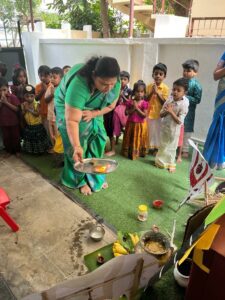
Uma Maheshwari is the correspondent of Playshaala. (Supplied)
Gathering humble offerings, including the ubiquitous Poolai poo, aavaaram poo, mango leaves, and neem leaves, the women in the family prepared bundles known as kaapu. Then, the unmarried men of the house would step in and carefully tie the kaapu in front of the house.
“The kaapu is also placed in important areas such as the prayer room and kitchen,” she says.
With the rising sun, two viragu aduppus, each holding pots, are arranged on the spot where the cow dung had been plastered and cleaned. The family then would come together to prepare a delightful spread of sakkarai pongal and pacharisi pongal. As the contents overflowed from the pots, the family used to joyfully exclaim, “Pongalo Pongal!”
Recounting this to us, Uma is evidently on a nostalgic journey. Having married at 16, the Pollachi native relocated to Tiruppur, where she has made her home. Yet, the memories of celebrations remain vivid for her, just as they do for Mehandi.
Despite moving to a different place, the Pongal celebrations have remained consistent. “My mother-in-law ensured we celebrated Pongal according to tradition. All the family members would be present at 5 am when the Pongal paanai is set up. Everyone would contribute to adding rice to the pot and say ‘Pongalo Pongal,'” she shares.
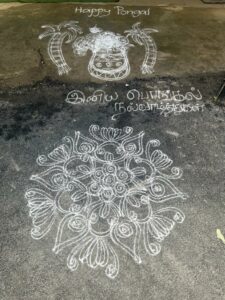
The threshold is plastered with cow dung, and cleaned before it’s decorated with a kolam. (Supplied)
“The current generation is too shy to say these things out loud!” she adds with a hint of nostalgia and amusement.
She pulls our attention back to her home in Pollachi, where the kitchen, during Pongal, is a melange of enticing fragrances. Freshly made pongal, a blend of aromatic spices, and the tangy aroma of Kayum kozhambu used to fill the air.
“Kayum kozhambu is one of the main dishes, featuring key ingredients like mochai, kathrikkai, and arasanikkai,” she enthusiastically shares.
When asked about her favourite part of Pongal, she doesn’t hesitate to respond. “Poo Pongal!” she exclaims.
On Poo Pongal or Kaanum Pongal day, a Pillayar (Lord Ganesha) doll made out of cow dung is placed in the house. If it’s a household with a girl child, the girl is traditionally presented with a new pavadai dress. “There would also be kummi performances. Besides a dress for Pongal, I would get a new dress for Poo Pongal, and that excited me!” she recalls.
In the evening, Uma, her mother, and others present in the house would sit outside, preparing to witness a spectacle. “Thousands of people from different villages on mattu vandis (bullock carts) used to go to the temple of the resident deity. We would witness this, sitting outside our house. They usually carry the Pillayar, then keep it in a river after visiting the temple,” shares Uma.
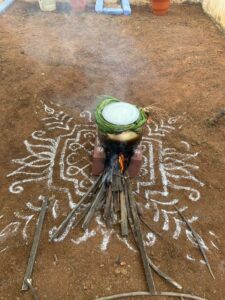
Uma ensures that certain traditions continue. (Supplied)
During Maatu Pongal, a makeshift theppakulam (pond) is created on the farm. Then, the cows are guided to dip in and then come out. “We drum a plate with a karandi (ladle) while uttering the words Vaai Kazhuvu Pattiyare as the cows take their refreshing dip. Afterwards, we encircle the cow thrice,” she details, providing insight into these age-old customs of the district.
Now, back home in Tiruppur, things are not as grand as they were when she was growing up in the 70s and 80s in Pollachi.
“I still set up the pongal pot by 5 am, following tradition. However, we don’t have as many people around it as before. Instead of a viragu aduppu, I now keep the pongal pot on a gas stove. Everyone has a tight schedule, and sometimes they are travelling, or they wake up late. Times have changed,” remarks the correspondent of Playshaala.
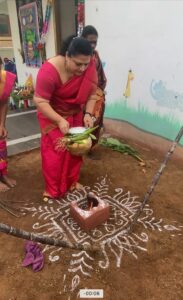
Poo Pongal used to be a special day for Uma. (Supplied)
Nevertheless, Uma ensures that certain traditions continue — not only within her family but also beyond. “In our school, I make it a point to celebrate Pongal the traditional way. We set up a viragu aduppu to show the children how it’s done! They also engage in creating kolams. I used to receive a pavada chattai as a gift during Poo Pongal, so I ensure I gift the same to my granddaughter,” she shares.
This year, with her granddaughter around, Uma is thinking of having a special Viragu Aduppu Pongal. She wants to share her memories by making paal pongal (milk pongal) and spending the day with her family. “I just want to cherish the traditions I grew up with,” she happily says.
About 300 kilometres away from Tiruppur, down south, in the village of Karuthapillayur in Thirunelveli district, the spirit of unity during festivals is something to witness. Here, people from diverse religious backgrounds converge to celebrate the joyous occasion of Tamizhar Thirunaal-Pongal.
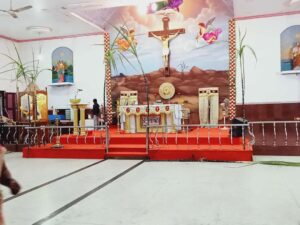
The entire community comes together to embellish the church altar with sugarcane. (Supplied)
For Ebenezer Disha, a nurse and native of the village, Pongal is synonymous with adorning the local church premise.
“The entire community comes together to embellish the altar and every nook of the church with the quintessential symbols of the harvest season. We decorate it with sugarcane, turmeric and of course, kolam! Most of us hail from agrarian families and this is an important festival,” shares Disha.
The Thai Pongal Day begins with a morning prayer service that imparts a special message.
“During the prayer service, the festival’s significance and the collaborative efforts of the community are emphasised,” says Disha. Post the service, attendees collectively set up viragu aduppus and prepare the traditional sweet pongal.
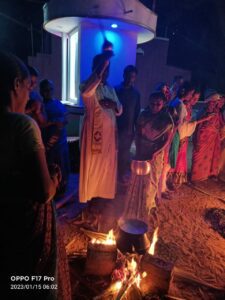
The priest is invited to bless the offerings. (Supplied)
“The church father is invited to bless the offerings. This enhances the spiritual aspect of the celebrations,” she notes.
“At home, our celebration includes the preparation of the traditional pongal dish and semiya payasam. A special highlight is the Pongal Kozhambu, a flavourful concoction with almost 30 different local vegetables, prepared in a large pot,” she shares.
This hearty dish is shared among families and is also heated and relished throughout the week.
Communal harmony is a cornerstone of the celebration at Karuthapillaiyur, it seems.
“Individuals from the Hindu community actively organise events, fostering an inclusive environment. Here everyone, irrespective of their faith, eagerly participates in the festivities,” she says.
The Maatu Pongal celebration extends with a charm. Every cow receives thorough attention — carefully bathed, their horns adorned with paintwork. “The culmination of this process occurs in the ground near the church,” says Disha.
“As the setting provides a charming backdrop, the church father offers prayers, sprinkles theertha thaneer (holy water), and imparts blessings upon the cows,” she shares.
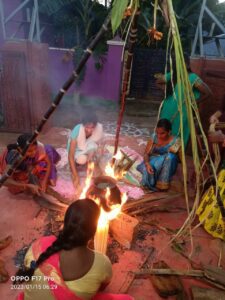
In embracing nature’s abundance, the village comes alive during the festive season. (Supplied)
In embracing nature’s abundance, the village comes alive with jubilation during this festive season.
“However, this year, as duty calls, I will be celebrating the festival in Chennai,” she adds.
Mehandi, Uma, and Disha, each following distinct faiths and traditions, find unity in the celebration of Thai Pongal. Although they may be physically distant from their respective roots on this day, their love for the festival are deeply rooted — yearning for the birth of a new vazhi (path) — while remembering their traditions.